Archaeology

Dec 23rd, 2025 - The 12 best things to do in Alexandria, Egypt - Lonely Planet . Alexander the Great spotted the potential of its deep harbor and founded his Egyptian capital here, creating a bridge between the land of the pharaohs and ancient Greece. In the end, Alexander never got to see the city that bears his name. He died in Persia, and his body was brought back to Memphis by his general, Ptolemy, who established the last great Pharaonic dynasty. Alexander's body was later moved to Alexandria, but the ... [Read More]
Source: lonelyplanet.com

Dec 18th, 2025 - It's quick and easy to access Live Science Plus, simply enter your email below. We'll send you a confirmation and sign you up for our daily newsletter, keeping you up to date with the latest science news. Facebook X Whatsapp Reddit Flipboard Join the conversation Add us as a preferred source on Google Newsletter Subscribe to our newsletter An excavation in Italy has unearthed the oldest and first known evidence of father-daughter incest in the archaeological record, a new genetic study reveals. ... [Read More]
Source: livescience.com

Dec 18th, 2025 - For fifteen days straight, amid pouring January rains, archaeologists from Historic England and Cotswolds Archaeology worked laboriously to unearth some historic secrets from the ancient Roman period. Squatting in the trenches of a dusty field in Gloucestershire, these treasure diggers were intending to close the chapter that was accidentally unlocked by a metal detectorist in March 2023. Deep in the northern heart of the Cotswolds, near the village of Willersey, two ... [Read More]
Source: greenmatters.com
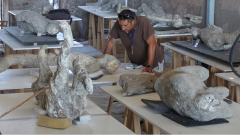
Dec 17th, 2025 - It's quick and easy to access Live Science Plus, simply enter your email below. We'll send you a confirmation and sign you up for our daily newsletter, keeping you up to date with the latest science news. Facebook X Whatsapp Reddit Flipboard Join the conversation Add us as a preferred source on Google Newsletter Subscribe to our newsletter Pompeii may have been unseasonably cold when the eruption of Mount Vesuvius destroyed the Roman city in A.D. 79, new research proposes. A new analysis of 14 ... [Read More]
Source: livescience.com
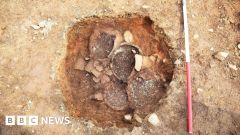
Dec 17th, 2025 - Newly published research has revealed a "mysterious mass burial event" in the south of Scotland about 3,300 years ago. Excavations were undertaken in 2020 and 2021 by Guard Archaeology during the construction of the access route to the Twentyshilling Wind Farm near Sanquhar in Dumfries and Galloway. It revealed a Bronze Age barrow - an ancient burial mound - with the cremated bones of several people contained inside five closely-packed urns. Archaeologist Thomas Muir, who led the excavation, ... [Read More]
Source: bbc.com

Dec 16th, 2025 - History from countries and communities across the globe, including the world's major wars. The stories behind the faiths, food, entertainment and holidays that shape our world. Tom Metcalfe A smoked mummy, a Pompeiian banquet room and a Neanderthal fingerprint are among the year's most intriguing discoveries. From ancient Maya kings to Vietnamese mummies to Egyptian pleasure barges, 2025 brought significant archaeological discoveries from all corners of the world. Some were stunning one-offs, ... [Read More]
Source: history.com

Dec 16th, 2025 - It's quick and easy to access Live Science Plus, simply enter your email below. We'll send you a confirmation and sign you up for our daily newsletter, keeping you up to date with the latest science news. Facebook X Whatsapp Reddit Flipboard Join the conversation Add us as a preferred source on Google Newsletter Subscribe to our newsletter Archaeologists in Egypt have uncovered the remains of a 4,500-year-old valley temple. The structure is part of a sun temple that ancient Egyptians built in ... [Read More]
Source: livescience.com

Dec 15th, 2025 - An Italian archaeological mission has discovered the remains of a sun temple belonging to an ancient Egyptian king near Cairo, the Egyptian antiquities ministry said. The temple of King Nyuserre is believed to be from the Fifth Dynasty and the remains were found in the Abusir necropolis south of the Egyptian capital. It is part of a monumental complex dedicated to the cult of the sun god Ra and is one of the few solar temples identified to date. The site was identified as early as 1901 by the ... [Read More]
Source: cbsnews.com
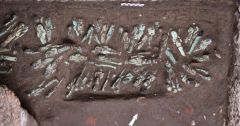
Dec 5th, 2025 - A treasure trove of 225 funerary figurines has been discovered inside a tomb in the ancient Egyptian capital of Tanis in the Nile Delta, a rare find that experts say has also solved a "long-standing archaeological mystery." "Finding figurines in place inside a royal tomb has not happened in the Tanis necropolis since 1946," French archaeologist Frederic Payraudeau told reporters in Paris on Friday. Such a find has also never happened before further south in Egypt's Valley of the Kings near ... [Read More]
Source: cbsnews.com

Nov 4th, 2025 - After two decades and an estimated cost of $1bn, the Grand Egyptian Museum (GEM) opened its doors to the public on Tuesday, just a few days after the official opening ceremony on Saturday. Regarded as the world's largest archaeological facility for a single civilisation, the museum is located 2km (1.2 miles) from the pyramids of Giza and 8km (5 miles) from the capital, Cairo. The complex spans nearly 500,000sq metres (5,381,900sq ft) and will house more than 100,000 ancient artefacts from the ... [Read More]
Source: aljazeera.com
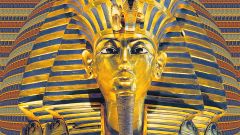
Nov 4th, 2025 - It's quick and easy to access Live Science Plus, simply enter your email below. We'll send you a confirmation and sign you up for our daily newsletter, keeping you up to date with the latest science news. QUICK FACTS Milestone: Staircase to King Tut's tomb uncovered When: Nov. 4, 1922 Where: Valley of the Kings, Egypt Who: An archaeological team led by Howard Carter On a sunny morning, Egyptian workers were clearing the sands at the Valley of the Kings, when they uncovered the hint of stone ... [Read More]
Source: livescience.com
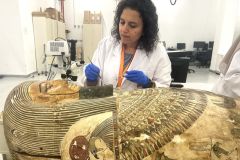
Oct 30th, 2025 - For the first time since the boy king's tomb was discovered in 1922, all the items will stored in one place, a museum director told NBC News. GIZA, Egypt — They're the crown jewels of the Grand Egyptian Museum — two galleries devoted to the ancient pharaoh Tutankhamun . Showcasing more than 5,300 objects from the young king's tomb, including his iconic death mask and glittering royal regalia, the new section of the vast museum here on the outskirts of Cairo is expected to draw ... [Read More]
Source: nbcnews.com
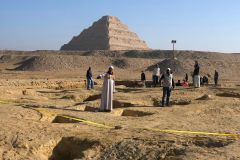
Oct 5th, 2025 - CAIRO (AP) — Egyptian antiquities officials on Sunday said a Pharaonic painting has disappeared from the famed Saqqara necropolis just outside of Cairo, becoming the latest artifact to disappear in a country known for its rich history. Mohamed Ismail, secretary-general of the Supreme Council of Antiquities, said the limestone painting was in the tomb of Khentika in the Saqqara necropolis. The mastaba tomb, which housed the painting, was found in the 1950s, and hasn't opened since 2019, he ... [Read More]
Source: aol.com
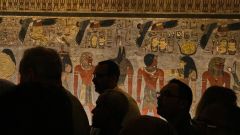
Oct 4th, 2025 - LUXOR, Egypt (AP) — Egypt on Saturday opened a tomb of a pharaoh for visitors after more than two decades of renovation in the southern city of Luxor, as it prepares for the official opening of the Grand Egyptian Museum in Cairo. The huge tomb of Amenhotep III, who ruled ancient Egypt between 1390 B.C. and 1350 B.C., is located on the western side of the famed Valley of the Kings. It was found in 1799 by two people and its contents were looted, including the sarcophagus, Egyptian ... [Read More]
Source: apnews.com
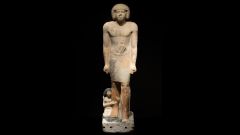
Sep 29th, 2025 - An "unparalleled" funerary statue of an ancient Egyptian man whose name may be Messi has been discovered at the Saqqara necropolis — and it shows him standing with what appears to be his tiny wife and even tinier daughter, who is holding a goose. Measuring just over 40 inches (103 centimeters) tall and carved out of limestone, "the most prominent figure depicted is that of a nobleman standing tall with an advancing left foot representing youth, vitality and strength," researchers wrote in ... [Read More]
Source: livescience.com

Sep 26th, 2025 - You can now listen to Fox News articles! Egyptian archaeologists recently uncovered a hidden harbor at an ancient temple connected to Cleopatra VII – an unexpected find for historians. The Egyptian Ministry of Tourism and Antiquities announced the discovery of the harbor on Sept. 18. It was found at the Temple of Taposiris Magna, about 30 miles west of Alexandria. The temple, built in the Ptolemaic era, was dedicated to Osiris, the Egyptian god of the afterlife. Though the temple ... [Read More]
Source: foxnews.com